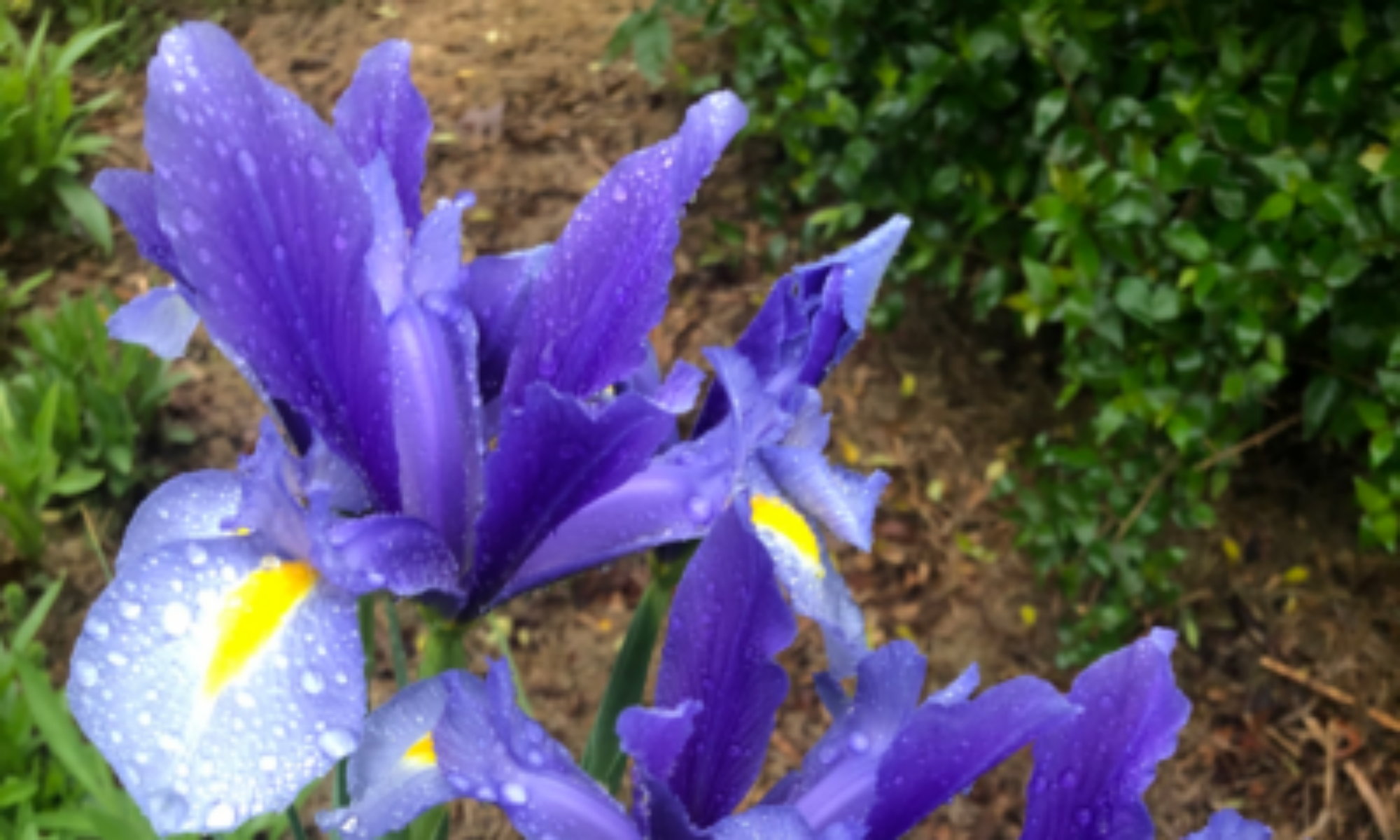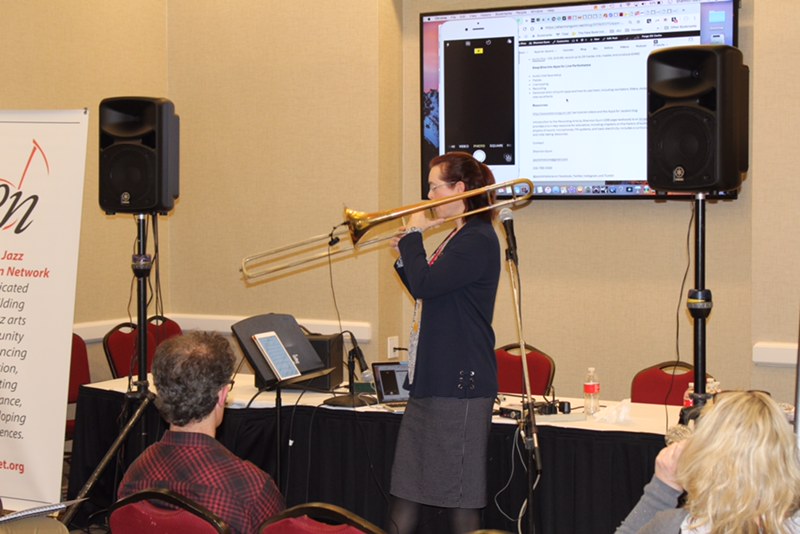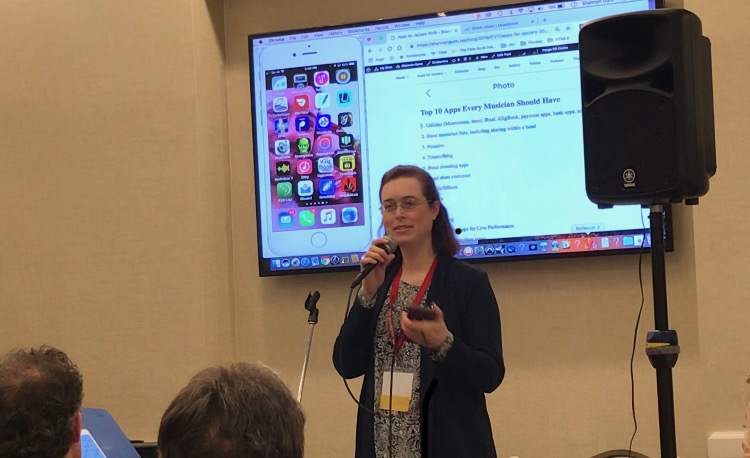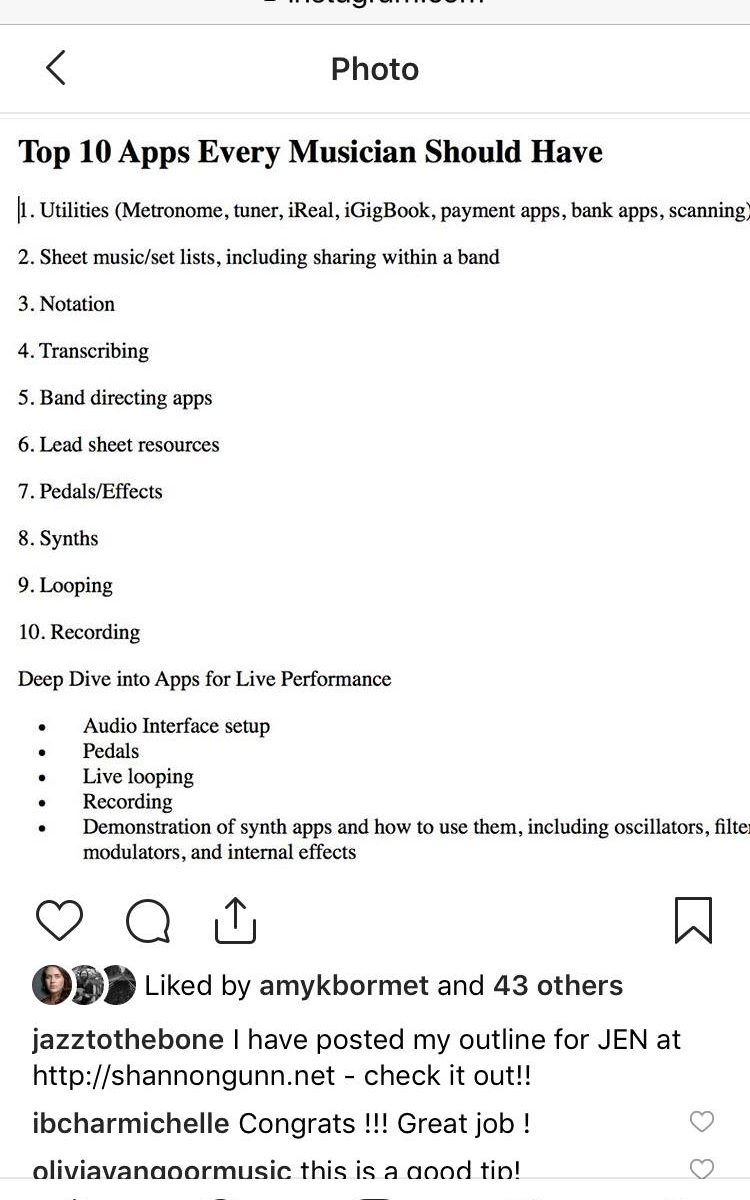By Shannon Gunn, presented at JEN 2019 (Reno, NV)
- Utilities (Metronome, tuner, iReal, iGigBook, payment apps, bank apps, scanning)
- Tempo by Frozen Ape – iOS, $2.99, playlists
- Pro Metronome – iOS, Android, Free, samples
- Tunable – iOS, Android, $3.99, includes pitch pipe and metronome
- TE Tuner (Tonal Energy Tuner) – iOS, Android, $3.99, smiley face
- iReal – iOS, Android, $12.99
- iGigBook – iOS, Android, $14.99
- CamScanner – iOS, Android, Free, upgrade to have cloud storage
- TurboScan – iOS, Android, $5.99
- PDF Filler – iOS, Android, browser, app is free for 30 days, $19.99/mo after that
- Notability – iOS, $9.99, sign contracts
- SignMyPad – iOS, Android, $3.99, sign contracts
- GoodNotes – iOS, $7.99, use Apple pencil to hand write, it comes with manuscript paper
2. Sheet music/set lists, including sharing within a band
- ForScore – iOS, $9.99, air turn, annotations, share set lists, turn pages across devices, tutorials
- UnReal Book – iOS, $8.99
- MobileSheets – Android, $12.99, set lists, annotations
3. Notation
- MuseScore – the desktop version allows you to write sheet music and load it to the website. The app is for viewing only (can’t write notation with it). Beware of $50 fee to download music to the app and the non-refund for cancelling subscription.
- Notion – iOS, $14.99
- Android sheet music apps, Sibelius, Finale, Noteflight
4. Transcribing
- Amazing Slow Downer (ASD) – iOS, Android, Lite is free but only 30 seconds of song, $14.99, import from music library or Spotify
- MimiCopy – iOS, $4.99, nice user interface for zooming and looping
- Transcribe! – Desktop software with frequency analyzer
5. Apps for band directors/students – ear training, theory, pedagogy, improvisation
- Stretch Music – iOS, $9.99, play along with Christian Scott Atunde Adjuah’s album, solo parts, view his sheet music
- Harmony Cloud – iOS, $9.99, Stefan Harris’s play along improvisation app
- Modacity – iOS, $8.99, music practice app, make a goal and watch your progress, make a playlist, take notes, recording, playback, set a timer, demos
- Anytune – iOS, free with in-app purchases $1.99 – $4.99, music practice app, slow down, speed up, loop, and separate out parts, transpose to a different key, play along with a recording
- Drum Genius – iOS, Android, free for the first three downloads, after that it ranges from $0.99 to $7.99, encyclopedia of drum grooves, practice along with Brian Blade
- PlayByEar – iOS, free, ear training app
- SR Machine (Sight Reading Machine) – iOS, $1.99, sight read difficult examples, demo
- ReadRhythm, aka Rhythm Reading Sight Reading Trainer – iOS, $2.99, tap along with sight reading, then receive a graphic of what you did, connect to Evernote to show improvement over time
- iImprov – iOS, Android, $4.99, this is a suite of apps which are short duration courses on everything jazz improv. Topics include: Scale Compendium, Modal, Fundamentals, Bebop, ii V, Contemporary Colors.
- Tenuto – iOS, $3.99, music theory app for students, associated with musictheory.net
- MyMusicTheory – Android, free, music theory app
- Music Theory Pro – iOS, $3.99, music theory app
- Fingering – iOS, $6.99, interactive fingering charts for brass and woodwind instruments
- Scales Lexicon – iOS, $4.99, over 100 scales, modes, jazz scales, and world music scales
- RhymeZone – iOS, browser, app is $2.99, browser is free, rhyming dictionary for lyrics
- Clapping Music – iOS, free, tap along with Steve Reich’s Clapping Music (gamified)
- GroupMuse – browser, iOS, free, social media app to host and attend classical chamber music house shows
6. Lead sheet resources
- Scribd, MuseScore, Google Images
7. Pedals/Effects/VSTs
- Ampkit – iOS, $19.99, hook your guitar into your iPad with the iRig for hundreds of pedals and amp modeling options
- Tonestack – iOS, $4.99, with expansion packs up to $24.99, hundreds of pedals, amp sims, and heads
- Cantabile – Windows, desktop app you can use for patches for your midi instrument (ex: Keyboard), $69 – $199
- Apple MainStage 3 – iOS desktop only, $29.99, live stage performance app for iOS
8. Synths
- MultiTone Generator – iOS, Android, free with $2.99 upgrade for all features, generate sine waves and adjust amplitude and frequency
- iMini – Desktop avail for Windows and iOS, iPad app also available, $9.99, this is an app created by Arturia which looks, feels, and acts just like the infamous MiniMoog, AudioBus compatible
9. Looping
- Loopy HD – iOS, $3.99, looper app, watch Jimmy Fallon’s demo on the tonight show
- Garageband – iOS, free, use the live loops and record, also includes the Alchemy synth
10. Recording
- Audiobus – iOS, $9.99, link your audio apps together to process and record, demo
- Aurio Pro – iOS, $49.99, record up to 24 tracks, mix, master, and produce (DAW)
Deep Dive into Apps for Live Performance
- Audio Interface setup
- Pedals
- Live looping
- Recording
- Demonstration of synth apps and how to use them, including oscillators, filters, modulators, and internal effects
Resources:
https://www.shannongunn.net has tutorial videos and the Apps for Jazzers blog
Introduction to the Recording Arts by Shannon Gunn (198 page textbook) is on Amazon and provides a turn-key resource for educators, including chapters on the history of audio recording, physics of sound, microphones, PA systems, and basic electricity. Includes a curriculum, exercises and note-taking resources.
Contact:
Shannon Gunn
[email protected]
216-789-5310
@jazztothebone on Facebook, Twitter, Instagram, and Tumblr
Shannon is available to do masterclasses and residencies at schools and universities.
Shannon Gunn and the Bullettes: http://www.bullettesjazz.com/
Bio:
Hailed by the Washington City Paper as “D.C.’s Best Trombonist 2015” and the DistrictNow Blog as “Best Trombonist 2017,” DC based Shannon Gunn is known for her exceptional tone and her grandiose project-du-jour. She is currently the artist in residence on Tuesday nights at Columbia Station in Adams Morgan as leader of the “Firebird Organ Trio,” named “DC’s Best Small Ensemble 2016” by the Washington City Paper. She also runs DC’s premiere all-women jazz orchestra, “Shannon Gunn and the Bullettes,” including successful performances at the Kennedy Center, Castleton Theatre House, DC Jazz Festival, Washington Women in Jazz Festival, Takoma Park Jazz Festival, Jazz on Jackson Place, Westminster Jazz Night, Nomadic Jazz, Great Gatsby Inaugural Ball, Goethe Institute, National Jazz Workshop, Gallery O on H, Arts on the Avenue, Bohemian Caverns, and Dardanella. As a member of the Bohemian Caverns Jazz Orchestra, she’s had the privilege of playing with notable artists such as Oliver Lake, Cheryl Bailey, Yotam Silverstein, Wycliffe Gordon, Ken Schaphorst, and for Miho Hazama. Additionally, as lead trombone player at Michigan State University, she played with Billy Taylor, Rodney Whitaker, and Marian McPartland. She earned her Masters of Music in Jazz Studies from George Mason University in Fairfax, Virginia and also attended James Madison University and Michigan State University for her music studies. She produced “The JazzCast,” a podcast dedicated to curated listening sessions with jazz musicians. In addition to the ensembles listed above, Shannon Gunn has performed with the Metropolitan Jazz Orchestra, Reunion Music Society, American Festival Pops Orchestra, Manassas Chorale, at various TV stations such as DCTV, CBS Morning Show (local) in Richmond, WJLA ABC in DC as part of the Gatsby Ball promo, and has subbed in with the DIVA! Jazz Orchestra for Maurice Hines’ “Tappin Thru’ Life” as well as subbed on tour with Monika Herzig. She resides in Virginia with her husband, Timothy, and her dog, Faith. Photo Credit Suzette Niess.




